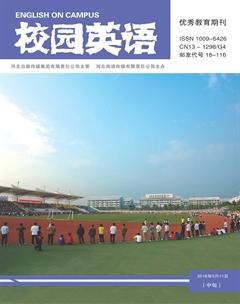New Strategy in the Reading Class of The Selected Articles from American & British Newspapers & Magazines
The course, The Selected Articles from American & British Newspapers & Magazines is one of the required courses for undergraduate English majors. As an extensive reading class, the course is designed to broaden students horizons, enhance their reading skills, taste the native speakers writing style, etc.
Until now, the reading class has won the significant percentage in the curricular of English majors. Firstly, reading is a primary step for language learners to master both their mother tongue and foreign language. In another word, the reading sometimes plays a more pivotal role than listening as a linguistic input. Secondly, the reading comprehension is also an indispensable part in all the English examinations both home and abroad.
In present, the course of The Selected Articles from American & British Newspapers & Magazines is rather underestimated compared with the intensive and extensive reading class. Besides, the textbooks, guiding books and teaching resources and materials are relatively inadequate and unsystematic. As a result, both the teacher and students would take it not serious enough, ignoring the true value of the studying the articles selected. Based on the teaching experience of the current author, the course could be more beneficial and rewarding for students if teaching methods would be modified.
These articles selected from Anglo-Saxon newspapers and magazines are actually not about the current news, but critical and expository articles covering international and domestic politics, economics, society, big shot,etc. As usual, the instructor would like to stress the significance of broadening the horizon and extending the vocabulary in the reading of the newspaper and magazine. Most teachers would be conscious of the difficulty and distance of the content while overlooking the delicate logic, up-to-date usage of language and various structures of those articles. Even though the course is designed to be multitasks,the best strategy should be to focus on just one: reading capacity improvement.
Due to the traditional exam-oriented education, there is a common mistake in reading capacity. In fact, reading capacity is not to find out, but to deal with the detailed information in the passage, including to abstract, summary and conclude information. It is easily observed that students lose themselves in the ocean of information, unable to put the various details in their proper positions in their reading. Many instructors just scratches the surface by informing what it is, instead of how it is.
One of the more effective methods is to give the students some specific objects during their reading. In this way, they would be forced to think more deeply and really practice the related capacity. However, the most difficult part is how to give the direction.
Compared with the short answer question presented in the text, the multiple-choice question is a better way. In the preparation period, the teacher divides the text into several parts based on the similarity of meaning of each paragraph; then, composes one multiple choice question in each part. The question is supposed to test students exact comprehension of some details or theme or both. In the class, after the necessary introduction of the background information, students would be given some time to read the part one by one to get the answer and then be allowed to discuss with the partner about his/her evidences backing up for the answer. During the process, students would present their understanding about each part. Consequently, from their elaboration, the teacher would find out their logical, lexical, syntactic or habitual mistakes in their comprehension.Naturally, the teacher is able to give them more exact and specific instructions.
After the implement of such strategy, the students in the class of the current author have acquired a more scientific reading methods. In summary, this mode of instructing presented above would bring many an advantage to the extensive reading class. To begin with, the students would feel involved in the class with their active communication. Each of them would be given some opportunities to express their own understandings. Their active participation is the first step of a concrete and successful class. Secondly, the teacher would have many evidences to identify students strength and weakness in comprehension and other learning defects. Based on what he/she has learned, the teacher would guide them in a more down-to-earth way. Lastly, the method would be applied smoothly even though students do not develop the habit of previewing. In a word, the mode of multiple-choice question will lead to a more rewarding and significant extensive reading class.
作者简介:姜睿睿(1990.5-),英语语言文学硕士,陇桥学院外国语言文学系教师。

